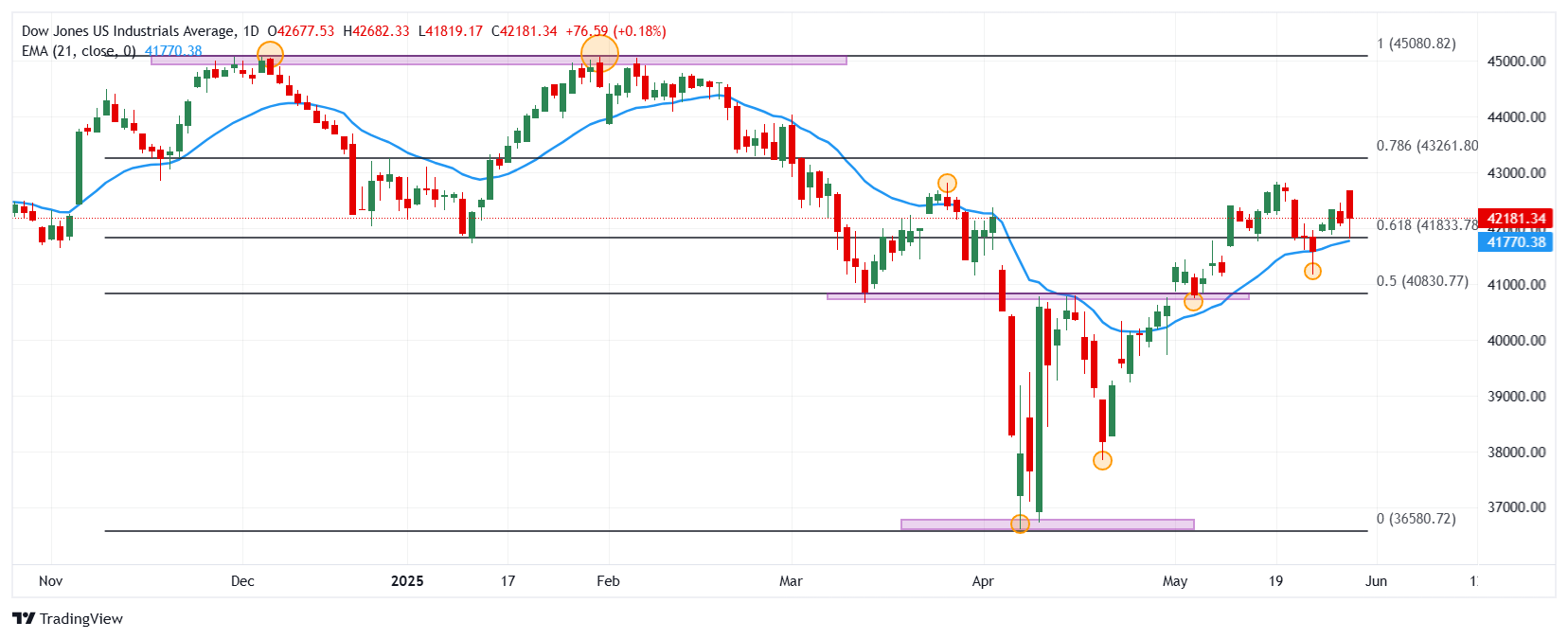- The Dow Jones advances 0.11% today, currently operating about 42 141.
- The Nasdaq 100 falls 0.05% daily, consolidating within the range of the previous session at 21,333.
- The S&P 500 rises 0.25% in the day, led by Nordson Corporation (NDSN).
- The United States International Court annulled the reciprocal tariffs imposed by Donald Trump.
- The preliminary gross domestic product of the US contracts 0.2% in the first quarter of the year, improving the expectations of analysts.
The Dow Jones reacted downwards from May 20 in 42,682, where he found aggressive vendors that took the index to May 23 in 41,819.
The Dow Jones industrial average began negotiations at 42,677, while the Nasdaq 100 technological index opened at 21,578. The S&P 500 began operating in 5,944, registering marginal profits during the session.
Nvidia and The Boeing Company lead the profits in the Dow Jones
The Dow Jones index wins 0.11% on Thursday, bouncing from minimum of four sessions in 41,819.
The titles of Nvidia (NVDA) register a daily rise of 3.12%, reaching maximums not seen since January 24 in $ 143.49, after the publication of your earnings report.
NVDA obtained income for $ 44.06 billion compared to 43.33 billion dollars planned, as well as an action of 0.81 $ compared to the 0.737 $ estimated by the market.
In the same tune, The Boeing Company (BA) shares earn 2.60% in the day, reaching maximums not seen since February 8, 2024 in 201.78 $.
In this sense, the Dow Jones rises 35 points, consolidating within the operational range of May 28 in 42,141.
ARM Holdings and Atlassian Corporation drag Nasdaq 100 to a negative field
The Nasdaq 100 technological index decreases 0.05% today, reaching a minimum of two days in 21,253.
Arm Holdings (ARM) values lose 5.90% daily, reaching minimum of May 23 at $ 126.75, ending with two consecutive upward days.
On the other hand, Atlassian Corporation titles (Team) fall 4.14% in the day, reaching minimums of three sessions, quoting the time of writing about 204.32 $.
The Nasdaq 100 slides 25 points, currently operating at 21,298.
The S&P 500 struggles to stay in positive terrain after the cancellation of reciprocal tariffs imposed by Donald Trump
The United States International Trade Court announced the cancellation of reciprocal tariffs promoted by the president of the United States, Donald Trump, arguing that they exceed the limits of the Law on International Emergency Emergency Powers (IEEPA), although the Trump administration is expected to appeal the decision before the Supreme Court.
After these events, the S&P 500 rises 15 points, winning 0.25% today, oscillating within the operational range of the previous session in 5,901. Nordson Corporation (NDSN) shares shoot 7.14% in the day, visiting maximums not seen since February 21 in 218.00 $.
On the other hand, the United States Economic Analysis Office announced that the preliminary gross domestic product of the first quarter contracted 0.2%, improving 0.3% prior and estimated by consensus.
Technical Analysis of Dow Jones
The Dow Jones established a short -term support given by the minimum of May 23 in 41,175. The following important support is 40,747, minimum of May 6 in convergence with the 50% fibonacci decline. To the north, the important resistance is located at 45,068, a pivot point of January 31.
Dow Jones daily graphics

Dow Jones Faqs
The Dow Jones Industrial Avenge, one of the oldest stock market indexes in the world, consists of the 30 most negotiated values in the United States. The index is weighted by the price instead of capitalization. It is calculated by adding the prices of the values that compose it and dividing them by a factor, currently 0.152. The index was founded by Charles Dow, also founder of the Wall Street Journal. In recent years it has been criticized for not being sufficiently representative, since it only follows 30 companies, unlike broader rates such as S&P 500.
There are many factors that promote the Dow Jones Industrial Average (DJIA) index. The main one is the added performance of the companies that compose it, revealed in the quarterly reports of business benefits. The American and world macroeconomic data also contribute, since they influence investor confidence. The level of interest rates, set by the Federal Reserve (FED), also influences the DJia, since it affects the cost of credit, on which many companies depend largely. Therefore, inflation can be a determining factor, as well as other parameters that influence the decisions of the Federal Reserve.
Dow’s theory is a method to identify the main trend of the stock market developed by Charles Dow. A key step is to compare the direction of the Dow Jones Industrial Avenge (DJIA) and the Dow Jones Transportation Average (DJTA) and just follow the trends in which both move in the same direction. The volume is a confirmation criterion. The theory uses elements of maximum and minimum analysis. Dow’s theory raises three phases of the trend: accumulation, when intelligent money begins to buy or sell; Public participation, when the general public joins the trend; and distribution, when intelligent money abandons the trend.
There are several ways to operate with the DJ. One of them is to use ETF that allow investors to negotiate the DJ as a single value, instead of having to buy shares of the 30 companies that compose it. An outstanding example is the SPDR Dow Jones Industrial Avenge ETF (day). Future contracts on the DJ allow the specular operators about the future value of the index and the options provide the right, but not the obligation, to buy or sell the index at a predetermined price in the future. Investment funds allow investors to buy a part of a diversified portfolio of DJ values, which provides exposure to global index.
Source: Fx Street
I am Joshua Winder, a senior-level journalist and editor at World Stock Market. I specialize in covering news related to the stock market and economic trends. With more than 8 years of experience in this field, I have become an expert in financial reporting.





